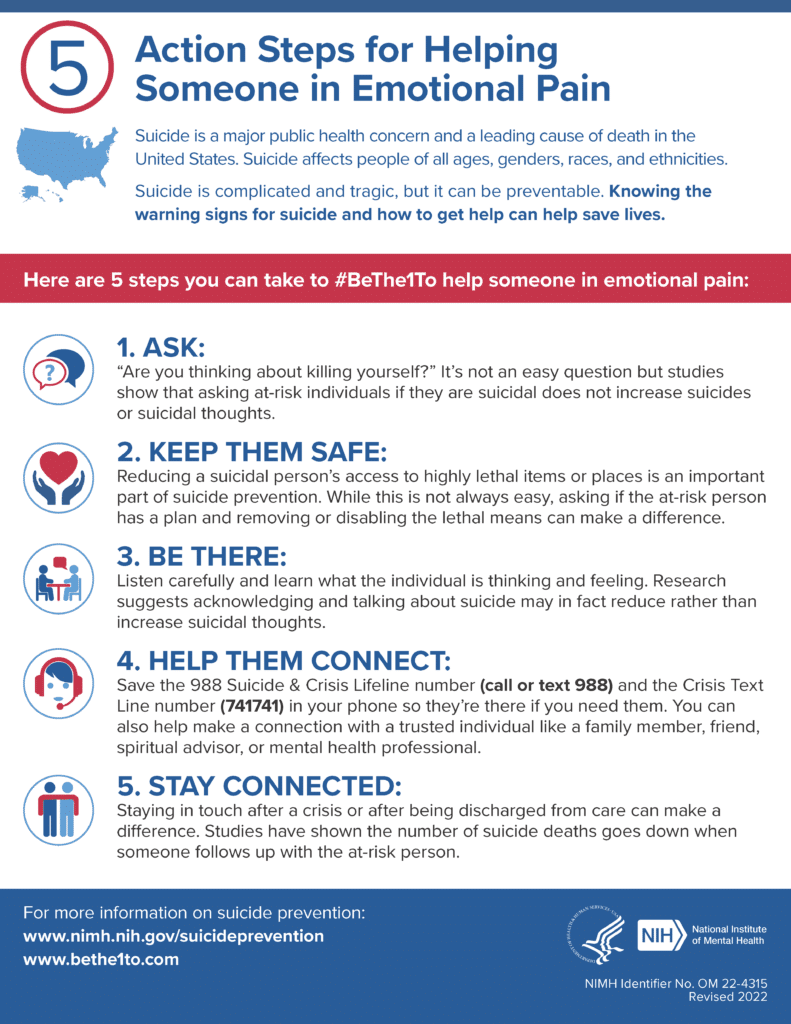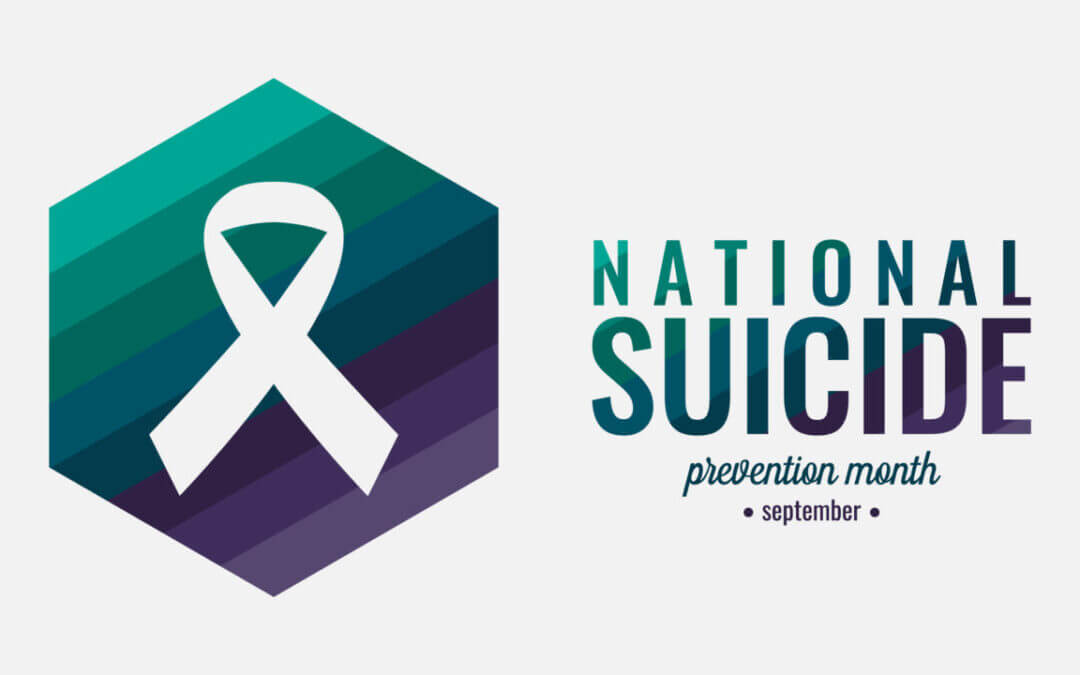Suicide is an uncomfortable topic to discuss but one that should be discussed openly and honestly. To help raise awareness and open the dialogue, September is recognized as National Suicide Prevention Awareness Month.
Suicide is a difficult topic, but silence can have tragic results. And those who are the sounding board for a suicidal friend or family member also need resources to help them navigate their journey in that role.
It’s important for everyone to remember that suicide’s reach goes far beyond the individual who is having suicidal thoughts and even actions. Those around them – family, friends, co-workers, neighbors, associates, etc. – are impacted as well. In addition, while a suicidal person may not directly ask for help, that doesn’t necessarily mean they don’t want help. So, what can someone do to help?
Recognizing warning signs
An important part – the first step actually – of suicide prevention is recognizing the warning signs and taking them seriously as well as knowing how to respond to them. Warning signs of suicide include:
- Talking about suicide.
- Looking for access to guns, pills, knives, etc.
- Having a preoccupation with death.
- Sudden mood swings or personality changes.
- Hopelessness.
- Self-loathing/hatred.
- Neglecting appearance.
- Changes in eating and sleeping patterns.
- Saying goodbye.
- Withdrawal.
- Self-destructive behavior.

Why suicide?
Many individuals often ask themselves, “Why would someone commit suicide?” “Isn’t that a selfish way to solve problems?” “Can’t they just get over whatever it is they are going through?” Unfortunately, individuals who have not personally struggled with a mental health disorder may have a hard time understanding why an individual would take their own life, and it may be impossible to put themselves in someone else’s shoes. It is crucial, however, to understand that regardless of the reason behind the suicidal ideations and attempts, the individual is genuinely struggling with deep-rooted emotional pain that may go beyond “snapping out of it.” The individual may be ashamed to ask for help, may not have a support system to be able to receive help or maybe too scared that finances could get in the way. As a family member, friend, coworker or loved one, it is imperative that we take our time to listen to individuals who are struggling and try to steer them in the right direction to receive professional help. Understanding the underlying reason these suicidal ideations are occurring, is essential to learn how to overcomes this struggle and develop healthy coping skills to combat and future setbacks.
Suicide prevention tips
1. If someone is worried about another individual, they are encouraged to speak up and start a conversation. Giving a suicidal person the opportunity to share their feelings can provide relief.
2. Respond quickly. It’s important to try to determine if the individual is in immediate danger.
3. Offer help and support.
Some things to do to offer support:
- Help find professional help for the individual and encourage him or her to go see someone.
- Be proactive about reaching out. Don’t wait for the person to call or ask for help. Stop by to visit, keep calling and invite the person out for dinner or even a walk.
- Encourage lifestyle changes that will positively affect the individual. Things such as a healthy diet, getting plenty of sleep, getting outside and so on.
- Make a safety plan. Assist in developing a plan for the individual so he or she can identify triggers and follow the steps that are determined to be most helpful. Include the contact numbers for the individual’s therapist (if applicable), crisis center hotline, Suicide Prevention Lifeline and other contacts who can help in an emergency.
- Continue supporting the individual long-term. Keep in touch, periodically stop by to visit, call to check in and remind the individual that there is hope.
Additional information to help provide support to someone who is considering suicide is available on the Mental Health America’s “For Family & Friends” webpage. “After an Attempt” is a guide provided by the National Suicide Prevention Lifeline and Substance Abuse and Mental Health Services Administration (SAMHSA), which provides helpful information for those who have attempted suicide as well those supporting them.

Get training:
Suicide Prevention QPR Gatekeeper – QPR stands for Question, Persuade, Refer – three simple steps that anyone can learn to help prevent a suicide and save a life. For more information about QPR, visit the QPR Institute’s website.
Additionally, the American Foundation for Suicide Prevention offers many training resources, as does the group, Suicide Awareness Voices of Education (SAVE), by providing tools to community leaders to help prevent suicideGet involved. During September, when the focus is on raising awareness for suicide prevention, it’s easier for individuals to join in to support those around them and in their communities. However, that support is needed all year long regardless of whether an individual is directly helping someone in need.
There are many ways to get and stay involved. Share information about suicide and suicide prevention on social media to help reduce the stigma associated with it. Keep the dialogue going with family and friends about the need for increased awareness and support. Volunteer at a local crisis shelter or similar organization. Donate to agencies who work nonstop to provide supporting services for individuals in need.
Prevention resources
There are many suicide prevention resources available, including:
- 988 Suicide & Crisis Lifeline – The Lifeline provides 24-hour, confidential support to anyone in suicidal crisis or emotional distress. 988 has been designated as the new three-digit dialing code that will route callers to the National Suicide Prevention Lifeline. Call or text 988 to connect with a trained crisis counselor. Support is also available via live chat. More information about 988 is available here.
- American Foundation for Suicide Prevention (AFSP) – Offers resources for suicide prevention for anyone in need, including resources supporting diverse communities and the LGBTQ community.
- Centers for Disease Control and Prevention (CDC) – Shares resources, facts, risk factors and more.
- National Institute of Mental Health (NIH) – Shares action steps to help someone and more.
- Suicide Prevention Resource Center (SPRC) – Shares multiple resources on suicide prevention.

